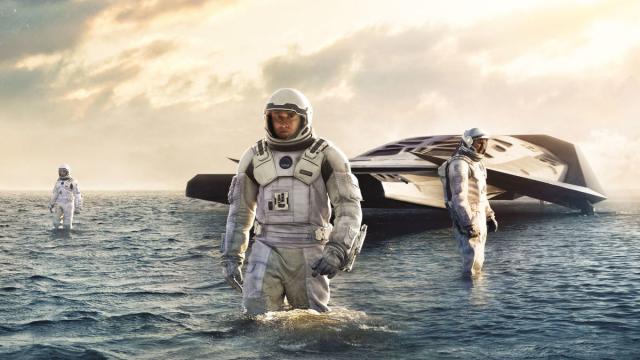Earlier this year, Earthlings rejoiced when scientists announced the discovery of three rocky exoplanets in the habitable zone of TRAPPIST-1, an “ultracool dwarf” star located just 39 light years away. Soon after, astronomers brought us back down Earth, pointing out that it might be hard for life to survive on a world in such a tight orbit around such a dim star. But the debate has now taken yet another delicious twist, this time, in favour of aliens.
Image: Warner Bros. Pictures
A pair of researchers at the at the Harvard Smithsonian Center for Astrophysics is positing that strong gravitational interactions between planets in red dwarf systems and their host stars could make these worlds more hospitable, particularly if they are “tidally locked”, with a permanent dayside and a permanent nightside. On tidally-locked ocean worlds, stellar-induced tides could promote nutrient mixing, helping to set up gradients of temperature and chemicals that might otherwise be absent.
Those gradients, in turn, could play a key role in the emergence of life.
“Let me start by confessing that this paper resulted from the inspiration I experienced after taking a photo on the Waikoloa beach in the island of Maui, Hawaii,” astronomer and lead study author Avi Loeb told Gizmodo. Loeb explained how that photo of the beach at sunset got him thinking about what it would be like to stand on the surface of a tidally-locked planet. (It is thought that many of the potentially-habitable worlds orbiting cool, red dwarf stars may be tidally locked, thanks to the gravitational tug of the very close-by star.)
“[This] led me to conclude that real estate values must peak at the permanent sunset strip on the surface of these planets,” Loeb said.
Indeed, other researchers have argued this perpetual “sunset strip” — the region between night and day — would be the most likely spot to offer mild climate conditions suitable for life. But biology may still struggle, due to the absence of certain physical and chemical processes induced by planetary rotation and by tides.
As Loeb put it, on a tidally locked world “there is no rhythm to the ocean-rock interface which some scientists regard as necessary for establishing life”. He explained how Earth’s tides, which are driven mainly by the Moon but also vary as our planet spins about its axis, give rise to cycles of flooding and evaporation that drive chemical reactions, including those that may have jumpstarted life.
But then, Loeb began to wonder: Could a planet that doesn’t have days and nights still develop a rhythm, due to strong gravitational interactions with its star?
“Shortly after taking the photo, I emailed my postdoc, Manasvi Lingam, and he followed up with detailed calculations and the write up of the paper, which shows that tides from the host star (or the milder tides from other planets in the TRAPPIST-1 system) can replace the role of the Earth’s spin on habitable planets around dwarf stars,” Loeb said.
Indeed, the tidal cycles induced by a nearby star are “orders of magnitude larger than those induced by the Moon on the Earth,” according to Loeb. The paper goes on to explore how these massive tides could drive flooding and evaporation along coastlines, drive oceanic Rossby waves (also known as planetary waves, these waves form as a result of the rotation of the planet), promote nutrient mixing, and on the whole, set the stage for complex chemical reactions to occur.
It’s important to note that this paper hasn’t been through peer review, meaning its ideas haven’t yet been vetted by the scientific community. At least one outside expert, astrobiologist Rocco Mancinelli at NASA’s Ames Research Center, thinks that the authors “hone in on some very good points” with regards to tides influencing planetary habitability.
“The fact is that having tides does increase the probability of chemical reactions that can lead to the origin of life,” Mancinelli told Gizmodo, noting that he co-authored a paper exploring this very concept back in 2007. The new study, he said, “reinforces a lot of the basic principles and premises brought forth in that older paper, in more detail.”
Mancincelli was a lot more sceptical, however, when it came to the authors’ hypotheses about tides influencing complex life. The paper suggests, for instance, that nutrient upwelling from stellar-induced tides might trigger massive algae blooms, offering astronomers a potential biosignature that we could spot from afar using telescopes.
“You get to more and more speculation — which doesn’t mean they’re wrong. But it’s a stretch,” he said.
It’s also important to remember that the premise of life existing at all in red dwarf star systems is speculative. It’s possible, for instance, that all of the TRAPPIST-1 planets have been stripped of their atmospheres due to powerful solar flares and stellar winds, leaving nothing but a handful of barren rocks.
Still, the notion that the gravitational pull of a nearby star would create tides on an ocean world, and that those tides could influence the planet’s livability, isn’t that wild. And at the very least, speculative ideas like alien algae blooms are food for thought as we continue exploring red dwarf systems for signs of life.
And hey, who knows, maybe the aliens are little green men, after all.
